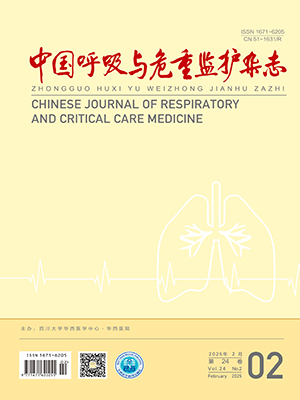| 1. |
中华医学会呼吸病学分会. 中国成人社区获得性肺炎诊断和治疗指南(2016 年版). 中华结核和呼吸杂志, 2016, 39(4): 253-279.
|
| 2. |
刘月, 刘晓民, 马雨霞, 等. 红细胞分布宽度与社区获得性肺炎严重程度及预后的关系. 中华肺部疾病杂志, 2016, 9(4): 434-435.
|
| 3. |
刘胜宝, 季汉华. 红细胞分布宽度及高敏 C 反应蛋白与行冠状动脉介入治疗的急性冠状动脉综合征患者出现对比剂肾病相关性研究. 中国循环杂志, 2015, 30(3): 220-224.
|
| 4. |
巫雪飞, 李巧, 赵连山. 红细胞分布宽度检验在慢性心衰患者早期诊断中的应用效果观察. 中国实验诊断学, 2015, 19(2): 235-237.
|
| 5. |
Balta S, Demirkol S, Hatipoglu M, et al. Red cell distribution width is a predictor of mortality in patients with severe sepsis and septic shock. Am J Emerg Med, 2013, 31(6): 989-990.
|
| 6. |
侯勇, 王联发, 周文兵, 等. 红细胞分布宽度、胱抑素 C 与冠状动脉病变程度的相关性分析. 心肺血管病杂志, 2014, 33(3): 353-355.
|
| 7. |
Salvagno GL, Sanchis-Gomar F, Picanza A, et al. Red blood cell distribution width: a simple parameter with multiple clinical applications. Crit Rev Clin Lab Sci, 2015, 52(2): 86-105.
|
| 8. |
Fine MJ, Auble TE, Yealy DM, et, al. A prediction rule to identify low-risk patients with community-acquired pneumonia. N Engl J Med, 1997, 336(4):243-250.
|
| 9. |
Welte T, Kohnlein T. Global and local epidemiology of community-acquired pneumonia : the experience of the CAPNETZ network.Semin Respir Crit Care Med, 2009, 30(2):127-135.
|
| 10. |
但勇, 覃双全. PSI 评分和 CURB-65 评分对社区获得性肺炎患者病情及预后的对比研究. 临床研究, 2012, 19(21): 29-32.
|
| 11. |
刘旭, 沈湘波, 李小玲. PSI 分数与 CURB-65 在社区获得性肺炎严重程度评价中的比较. 中国医学创新, 2011, 8(18): 181-182.
|
| 12. |
Falk G, Fahey T. C-reactive protein and community-acquired pneumonia in ambulatory care: systematic review of diagnostic accuracy studies. Fam Pract, 2009, 26(1): 10-21.
|
| 13. |
易高, 方向明, 林纯意, 等. 红细胞分布宽度在社区获得性肺炎严重度分层中的预测价值. 中国呼吸与危重监护杂志, 2014, 13(4): 374-377.
|
| 14. |
中国医药教育协会感染疾病专业委员会. 感染相关生物标志物临床意义解读专家共识. 中华结核和呼吸杂志, 2017, 40(4): 243-257.
|
| 15. |
杨德平, 狄勇. PCT、WBC、CRP 联合检测对早期细菌感染性疾病的诊断价值. 国际检验医学杂志, 2014, 35(11): 1485-1486.
|
| 16. |
李树林, 顾畅. 降钙素原、C-反应蛋白、白细胞计数和中性粒细胞百分比在肺部感染性疾病早期诊断中的应用. 中国卫生检验杂志, 2016, 26(16): 2343-2345.
|
| 17. |
陈丽萍, 丛立, 陈颖, 等. 血清降钙素原检测对革兰阴性菌或革兰阳性菌血流感染的诊断价值. 中国呼吸与危重监护杂志, 2014, 13(4): 374-377.
|
| 18. |
周冰, 邢菊, 周丽娟. C-反应蛋白、临床肺部感染评分在社区获得性肺炎中的临床价值.实用临床医学. 2016, 17(6): 8-10.
|
| 19. |
朱婉凌, 王敏, 王小亚. 乳酸、降钙素原、CURB-65 评分在老年社区获得性肺炎预后评估中的作用.中国医学工程, 2015, 23(1): 9-10.
|
| 20. |
江桂忠, 廖伟群, 赖晓宇. 红细胞分布宽度与老年重症社区获得性肺炎患者病情严重程度及预后的相关性分析. 广州医药, 2016, 47(1): 67-70.
|
| 21. |
张俨, 李文强. 降钙素原对社区获得性肺炎死亡率及病情评估的价值. 临床肺科杂志, 2015, 20(8): 1468-1471.
|




